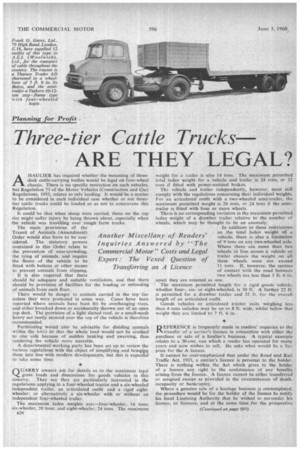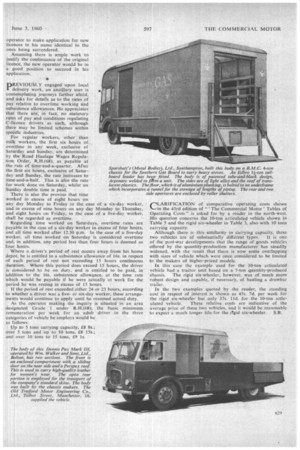Three-tier Cattle Trucks ARE THEY LEGAL?
Page 72

Page 75

If you've noticed an error in this article please click here to report it so we can fix it.
AHAULIER has inquired whether the mounting of threedeck cattle-carrying bodies would be legal on four-wheel chassis. There is no specific restriction on such vehicles, but Regulation 73 of the Motor Vehicles (Construction and Use) Regulations, 1955, relates to safe loading. It would be a matter to be considered in each individual case whether or not threetier cattle trucks could be loaded so as not to contravene this Regulation.
It could be that when sheep were carried, those on the top tier might suffer injury by being thrown about, especially when the vehicle was travelling over rough farm tracks.
The main provisions of the Transit of Animals (Amendment) Order would also have to be considered. The statutory powers contained in this Order relate to the prevention of over-crowding, the tying of 'animals, and require the floors of the vehicle to be fitted with battens or other means to prevent animals from slipping.
It is also required that there should be adequate and suitable ventilation, and that there should be provision of facilities for the loading or unloading of animals from each floor.
" There would be danger to animals carried in the top tier unless they were protected in some way. Cases have been reported where animals have been hit by overhanging trees, and either knocked down or accidentally thrown out of an open top deck. The provision of a light slatted roof, or a small-mesh heavy net tautly secured over the top of the vehicle is therefore recommended.
Partitioning would also be advisable for dividing animals within the lorry so that the whole load would not be crushed to one side because of sudden braking and swerving, thus rendering the vehicle more unstable.
A departmental working party has been set up to review the various regulations with the object of simplifying and bringipg them into line with modern developments, but this is expected to take some time.
QtJARRY Q waers ask for details as to the maximum legal gross loads and dimensions for goods vehicles in this country. They say they are particularly interested in the regulations applying to a four-wheeled tractor and a six-wheeled independent trailer, an articulated outfit and a rigid eightwheeler; or alternatively a six-wheeler with or without an independent four-wheeled trailer.
The maximum laden weights are:—four-wheeler. 14 tons: siv.-wheeler, 20 tons; and eight-wheeler. 24 tons. The maximum B26
weight for a trailer is also 14 tons. The maximum permitted total laden weight for a vehicle and trailer is 24 tons, or 32 tons if fitted with power-assisted brakes.
The vehicle and trailer independently, however, must still comply with the regulations concerning their individual weights. For an articulated outfit with a two-wheeled semi-trailer, the maximum permitted weight is 20 tons, or 24, tons if the semitrailer is fitted with four or more wheels.
There is no corresponding variation in the maximum permitted laden weight of a drawbar trailer relative to the number of wheels, which may be thought to be an anomaly.
In addition to these restrictions on the total laden weight of a vehicle, there is also a limitation of 9 tons on any two-wheeled axle. Where there are more than two wheels in line across a vehicle or trailer chassis the weight on all these wheels must not exceed 11 tons. If, however, the centres of contact with the road between two wheels are less than 1 ft. 6 in. apart they are counted as one.
I The maximum permitted length for a rigid goods vehicle, whether four-, sixor eight-wheeled, is 30 ft: A further 22 ft. is permitted for a drawbar trailer and 35 ft. for the overall length of an articulated outfit.
Goods vehicles or articulated tractor units weighing less than 4 tons unladen may be up to 8 ft, wide, whilst below that weight they are limited to 7 ft. 6 in, REFERENCE is frequently made in readers' inquiries to the transfer of a carrier's licence in connection with either the purchase or sale of a haulier's business. A typical example relates to a 30-cwt. van which a reader has operated for many years and now wishes to sell. He asks what would be a fair price for the A licence.
It cannot be over-emphasized, that under the Road and Rail Traffic Act, 1933, a carrier's licence is personal to the holder. There is nothing within. the Act which gives to the holder of a licence any right to the continuance of any benefits arising from the .licence., A licence cannot be either transferred or assigned except as provided in the circumstances of death, incapacity or bankruptcy. .
Where a genuine sale of a haulage business is contemplated, the procedurewould be for the holder of the licence to notify his local Licensing Authority that he wished to surrender his licence, or licences, and at the same time for the prospective
DREVIOUSLY engaged upon local 1delivery work, an ancillary user is contemplating journeys farther afield, and asks for details as to the rates of pay relative to overtime working and subsistence allowances. He appreciates that there are, in fact, no statutory rates of pay and conditions regulating C-licence drivers as such, although there may be limited schemes within specific industries, For regular workers, other than milk workers, the first six hours of overtime in any week, exclusive of Saturday and Sunday, are determined by the Road Haulage Wages Regulation Order., R.11.(68), as payable at the rate of time-and-a-quarter. After the first six hours, exclusive of Saturday and Sunday, the rate increases to time-and-a-half. This is also the rate for work done on Saturday,-whilst on Sunday double time is paid.
There is also the proviso that time worked in excess of eight hours on any day Monday to Friday in the case of a six-day worker, and in excess of nine hours on any day Monday to Thursday, and eight hours on Friday, in the case of a five-day worker, shall be regarded as overtime.
Regarding time worked on Saturdays, overtime rates are payable in the case of a six-day worker in excess of four hours, and all time worked after 12.30 p.m. In the case of a five-day worker, all time worked on Saturday is considered overtime and, in addition, any period less than four hours is deemed as four hours.
Where a driver's period of rest occurs away from his home depot, he is entitled to a subsistence allowance of 16s, in respect of each period of rest not exceeding 15 hours continuous duration. Where this period does exceed 15 hours, the driver is considered to be on duty, and is entitled to be paid, in addition to the 16s. subsistence allowance, at the time rate which would be payable if be were actually at work for the period he was resting in excess of 15 bona If the period of rest exceeded either 24 or 23 hours, according to whether a driver was a fiveor six-day worker, these arrangements would continue to apply until he resumed actual duty.
As the operator making the inquiry is situated in an area designated Grade 1 under R.H.(68), the basic minimum remuneration per week for an adult driver in the three categories of vehicle he employs would be as follows: Up to 5 Ions carrying capacity, £8 Rs.; over 5 tons and up to 10 tons, £8 15s.; and over 10 tons to 15 tons, £9 Is. OLARIFICATION of comparative operating costs shown in the 43rd edition of "'The Commercial Motor' Tables of Operating Costs" is asked for by a reader in the north-west. His question concerns the 10-ton articulated vehicle shown in Table 5 and the rigid six-wheeler in Table 3, also with 10 tons carrying capacity.
Although there is this similarity in carrying capacity, these two vehicles are of substantially different types. It is one of the post-war developments that the range of goods vehicles offered by the quantity-production manufacturer has steadily widened, with the result that there is now some overlapping with sizes of vehicle which were once considered to be limited to the makers of higher-priced models.
In this case the example used for the 10-ton articulated vehicle had a traetor unit based on a 7-ton quantity-produced chassis. The rigid six-wheeler, however, was of much more robust design and capable, if necessary, of hauling a drawbar trailer.
In the two examples quoted by the reader, the standing cost in respect of interest is shown as 45s. 7d. per week for the rigid six-wheeler but only 37s. 1 ld. for the 10-ton articulated vehicle. • These relative casts are indicative of the aVerage price of these two vehicles, and it would be reasonable to expect a much longer life for the el'gid six-wheeler. S.B.
















































































































